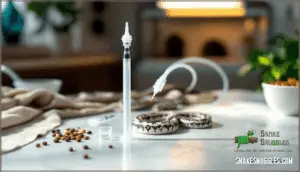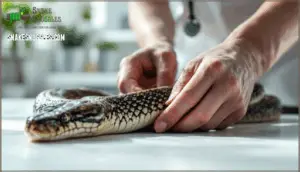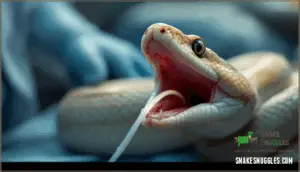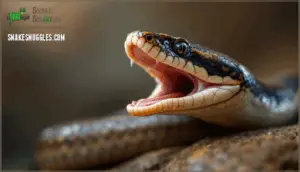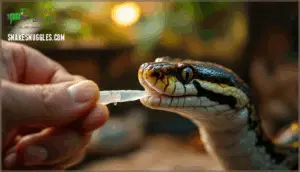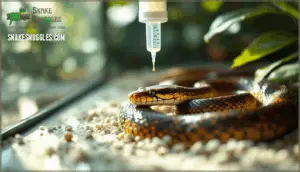This site is supported by our readers. We may earn a commission, at no cost to you, if you purchase through links.

This technique bypasses the snake’s natural feeding response by delivering a nutritional formula directly into the stomach, providing life-sustaining calories while you address the underlying cause of anorexia.
Tube feeding demands anatomical precision, sterile technique, and careful calculation of volume and frequency to avoid aspiration, regurgitation, or gastrointestinal trauma. Mastering this procedure can mean the difference between losing a patient and guiding them back to self-sustained feeding.
Table Of Contents
- Key Takeaways
- Preparing a Snake for Tube Feeding
- Choosing and Preparing Feeding Tube Equipment
- How to Feed a Snake With a Feeding Tube
- Determining Tube Feeding Frequency and Volume
- Monitoring and Caring for Tube-Fed Snakes
- Frequently Asked Questions (FAQs)
- How do you feed a pet snake?
- How do snakes eat?
- Can a snake eat a tube?
- How to feed a 100 gram snake?
- Do snakes need a feeding tub?
- How is tube feeding performed in critically ill snakes?
- What are the risks of tube feeding snakes?
- How to choose the right feeding tube size?
- Can tube feeding cause stress in snakes?
- What signs indicate improper tube feeding?
- Conclusion
Key Takeaways
- Tube feeding becomes critical when snakes lose more than 10% body weight over two weeks or show visible vertebral processes, requiring precise anatomical placement and sterile technique to prevent aspiration, regurgitation, or organ failure while addressing the underlying cause of anorexia.
- Success depends on proper preparation—including achieving full hydration (20-40 ml/kg/day subcutaneously), maintaining core temperature between 82°F-88°F, and ensuring correct tube placement by measuring externally to the stomach (approximately halfway down the body) while avoiding the ventral glottis entirely.
- Formula delivery must be conservative and calculated, starting at 0.5%-2% of body weight for debilitated patients and never exceeding 2%-5% per feeding, with weekly intervals between sessions to prevent regurgitation and allow complete gastric emptying.
- Post-feeding monitoring is essential—track weight trends, hydration status, and stool production after each session, and seek veterinary consultation immediately if regurgitation occurs more than twice in five feedings, weight loss exceeds 10% baseline, or respiratory distress develops.
Preparing a Snake for Tube Feeding
Before you attempt tube feeding, you need to verify your snake is physically ready for the procedure. This preparation phase tackles critical factors that directly impact feeding success and patient safety.
The following sections cover assessment, environmental setup, hydration protocols, and stress reduction techniques that establish the foundation for safe assisted feeding.
Assessing The Need for Tube Feeding
You’ll know tube feeding is necessary when weight loss exceeds 10% over two weeks, or when vertebral processes become visible through muscle loss. Don’t rush this decision—anorexia isn’t always an emergency, since 72% of snake species naturally fast during brumation.
Watch for dehydration, persistent refusal of prey after environmental corrections, or declining body condition scores below 0.2 weight-to-length ratio. Assisted feeding becomes critical when natural feeding challenges threaten your snake’s survival. Proper reptile care is essential to prevent these issues.
Creating an Appropriate Environment
Before you even consider inserting a feeding tube, your snake’s enclosure must replicate the thermal and humidity parameters that support normal digestive function—otherwise, you’re setting up both the animal and yourself for regurgitation or metabolic complications. Establish these five husbandry requirements immediately:
- Temperature gradient from 75°F cool end to species-appropriate basking zone
- Humidity levels matching natural habitat (30%-70% depending on species)
- Lighting options providing 12-hour photoperiod without thermal stress
- Enclosure size allowing full-body stretching and thermoregulation
- Environmental enrichment including hide boxes and water bowls for hydration
Temperature control directly influences gastric motility—your snake can’t digest food in suboptimal conditions, no matter how carefully you’ve tube-fed it.
Hydration and Warming Protocols
Your snake requires two critical conditions before tube feeding: full hydration and an ideal core temperature. Neglecting either condition increases the risk of aspiration, regurgitation, or metabolic shutdown. If dehydration is evident—characterized by sunken eyes, skin tenting, or lethargy—administer fluid therapy at 20-40 ml/kg/day subcutaneously or intracoelomically to restore hydration and support gastric function.
Maintaining the snake’s body temperature within species-specific ranges is essential, as temperature directly influences enzymatic activity necessary for digestion. Utilize controlled heat sources and monitor humidity levels throughout the warming period. The core temperature should remain within 82°F-88°F, depending on the species, to ensure metabolic processes function optimally.
| Parameter | Target Range | Monitoring Method |
|---|---|---|
| Core Temperature | 82°F-88°F (species-dependent) | Digital thermometer probe |
| Hydration Status | Normal skin turgor, clear eyes | Physical examination, weight tracking |
| Warming Duration | 2-4 hours minimum | Temperature gradient verification |
| Fluid Volume | 20-40 ml/kg/day | Syringe measurement, body condition |
Temperature control is crucial for facilitating enzymatic activity required for digestion. Without adequate thermal energy, your snake will be unable to process tube feeding effectively.
Minimizing Stress During Preparation
Once your snake reaches the right temperature and hydration level, you’ll need to keep contact time short and movements deliberate—every extra minute of restraint compounds physiological stress that can derail digestion.
Stress reduction during prefeeding protocols demands gentle restraint techniques and minimal environmental disruption. Dim lighting and reduced noise support your snake’s neurological comfort, while familiar enclosure scents preserve behavioral stability.
Don’t chase or corner your patient; approach calmly to prevent defensive responses that increase cortisol and inhibit gastric motility, essential for successful assisted feeding.
Choosing and Preparing Feeding Tube Equipment
Before you begin tube feeding, you’ll need the right equipment and proper preparation. The tube itself must match your snake’s anatomy, and everything should be clean and ready to use.
Here’s what you need to know about selecting, assembling, and sterilizing your feeding supplies.
Selecting The Correct Tube Size and Type
The diameter and length of your feeding tube aren’t just technical details—they’re the difference between a smooth feeding and a dangerous airway obstruction. You’ll need a relatively wide-bore tube that accommodates the nutritional formula without clogging. The length must reach the stomach, which sits roughly at the snake’s midpoint.
Red rubber or silicone tubes work best for enteral feeding, as they’re flexible enough to navigate snake anatomy without causing trauma during tube placement.
Assembling Required Supplies
Before you insert a single milliliter of formula, gather every supply within arm’s reach—fumbling mid-procedure stresses both you and your patient.
Your supply checklist includes the feeding tube, syringe for formula preparation, lubricant for smooth insertion, restraint towel, and measured nutritional formula. Tube measurement should already be marked to the stomach location. You’ll also need clean water for flushing the reptile feeding tube post-administration.
Having everything ready transforms enteral feeding from chaotic to controlled.
Hygiene and Sterilization Practices
Contaminated equipment transforms a life-saving procedure into a pathogen highway, so sterilization isn’t optional—it’s the foundation of every successful tube feeding. Proper sanitation procedures protect reptile health as effectively as sterile equipment protects wound care sites during anesthesia.
Contaminated equipment turns a life-saving procedure into a pathogen highway—sterilization is the foundation of every successful tube feeding
Clean your reptile feeding tube with warm soapy water after each use, then disinfect with diluted chlorhexidine or similar veterinary-grade solution. Rinse thoroughly before storage—residual disinfectant irritates mucosa. Replace tubes showing wear, cracks, or discoloration.
How to Feed a Snake With a Feeding Tube
With the proper equipment prepared, you’re ready to execute the actual feeding procedure. Safe restraint, accurate tube placement, and controlled formula delivery determine whether this intervention succeeds without complications.
The following steps will guide you through each phase of the process, from securing your patient to removing the tube after feeding.
Restraining The Snake Safely
Proper restraint isn’t just about control—it’s about protecting both you and your patient from injury while minimizing the stress that could trigger regurgitation or defensive behavior. Support the snake’s body along its length, distributing weight evenly to prevent musculoskeletal strain.
For debilitated reptiles with anorexia, gentle manipulation is critical—avoid sudden movements that escalate anxiety. In fractious cases, light anesthesia may be warranted, though most tube feeding procedures succeed with calm, confident management and appropriate safety precautions.
Locating The Esophagus and Stomach
Once you’ve got your snake properly restrained, the next step is finding the esophagus. Unlike mammals with their distinct tracheal opening, snakes make this surprisingly straightforward since their glottis sits far forward on the floor of the mouth.
Your anatomy guide is simple: the esophagus runs dorsally along the midline. For proper reptile feeding tube placement, you’ll measure externally from the mouth to the stomach location—approximately halfway down your patient’s body length.
This esophageal intubation technique guarantees accurate tube insertion depth for safe feeding techniques.
Inserting and Positioning The Feeding Tube
With your measurements confirmed and the snake securely restrained, you’re ready to advance the tube through the mouth and down into the esophagus—a move that demands both confidence and precision to avoid injury.
Your tube placement technique should follow these critical steps:
- Guide the feeding tube gently along the dorsal midline, avoiding the ventral glottis entirely
- Advance steadily to your premeasured depth, feeling for resistance that signals stomach entry
- Verify tube security by checking tube position remains stable before proceeding with formula delivery
Proper esophagostomy tube placement and reptile feeding tube placement protect delicate snake anatomy while establishing reliable access for nutritional support.
Administering The Nutritional Formula
Now that the tube rests securely at stomach depth, you’ll deliver the nutritional formula slowly and steadily to prevent complications like regurgitation or aspiration. Your formula preparation should match species-specific snake nutrition requirements, balancing calories with digestive health considerations. Attach your syringe and depress the plunger gradually—don’t rush.
Proper feeding techniques during tube feeding guarantee nutritional support reaches the stomach without stressing delicate tissues. Monitor tube maintenance throughout—any resistance signals you should pause and reassess positioning before continuing formula delivery.
| Parameter | Recommended Range | Clinical Consideration |
|---|---|---|
| Formula Volume | 2%-5% body weight | Stomach capacity limits; prevents overdistension |
| Administration Rate | 1-2 ml per 10 seconds | Slow delivery minimizes aspiration risk |
| Formula Temperature | 25-30°C (77-86°F) | Matches ideal digestive enzyme activity |
| Feeding Frequency | Weekly intervals | Allows complete gastric emptying between sessions |
Ensuring Proper Tube Removal
After you’ve delivered the formula, withdrawing the tube correctly protects both the snake’s delicate esophageal lining and your investment in the feeding process. Pinch the tube gently to prevent formula backflow, then retract with steady, controlled motion—no jerking movements that risk mucosal damage.
Tube removal tips emphasize slow withdrawal to support esophagus healing and minimize complications of tube feeding.
Post removal monitoring includes watching for respiratory distress or abnormal behavior, critical markers for snake recovery and successful reptile feeding tube care.
Determining Tube Feeding Frequency and Volume
Getting the formula volume and feeding schedule right isn’t just about filling the stomach—it’s about supporting recovery without overwhelming your snake’s digestive system. You’ll need to calculate precise volumes based on your snake’s body weight and stomach capacity, then space feedings to allow complete digestion.
The following sections break down the calculations, timing considerations, and safety measures that prevent regurgitation and metabolic complications.
Calculating Stomach Capacity and Food Volume
Accurate calculations drive safe tube feeding. You’ll need to determine your snake’s gastric capacity—usually 2% to 5% of body weight—and match it with the right caloric intake to avoid overfeeding or refeeding syndrome.
- Weigh your snake on a gram scale before each feeding tube session to calculate precise volumes based on current body weight
- Start conservatively at 0.5% to 2% of body weight for debilitated patients, delivering roughly 2–5 milliliters for a 100-gram snake
- Use the formula 32 × (body weight in kilograms)^0.75^ to estimate daily maintenance energy requirements and deliver 50–75% initially
- Gradually increase food volume only after successful feedings without regurgitation, abdominal bloating, or disrupted stool production
Setting an Appropriate Feeding Schedule
Your feeding frequency hinges on the snake’s metabolic state, baseline health, and how well it tolerated the initial volumes. Start with weekly tube feeding intervals for most debilitated patients, then adjust based on weight trends and digestive tolerance. Calculating caloric requirements against maintenance energy requirements helps you tailor meal planning to each snake’s dietary needs.
| Patient Status | Feeding Frequency |
|---|---|
| Critically ill | Every 5–7 days |
| Stable recovery | Every 7 days |
| Improving condition | Every 5–7 days |
| Near voluntary feeding | Every 7–10 days |
Avoiding Overfeeding and Regurgitation
Regurgitation often strikes when you push the stomach’s limited capacity past its threshold or rush the snake’s recovery period. Stick to 2%-5% of body weight per feeding and watch for early warning signs—restlessness, open-mouth breathing, or abnormal posturing after tube feeding.
Space your feedings at least five to seven days apart to prevent overfeeding risks and support digestive health, giving the snake adequate time to process calories and avoid anorexia relapse.
Monitoring and Caring for Tube-Fed Snakes
Once you’ve successfully tube fed your snake, your work isn’t done—it’s just shifting gears.
The days and weeks following assisted feeding require close attention to verify your patient tolerates the intervention and begins recovering. You’ll need to watch for warning signs, track key health metrics, and recognize when it’s time to step back or call in professional help.
Observing for Complications and Side Effects
Vigilance during the recovery period can prevent serious complications in hospitalized snakes receiving assisted feeding. Watch closely for regurgitation risk—holding the cranial half elevated post-feeding reduces this threat.
Tube blockage, infection signs around the insertion site, and adverse feeding reactions demand immediate attention. Metabolic issues may manifest as persistent anorexia or lethargy, signaling the need to reassess your tube feeding techniques and environmental parameters before complications escalate.
Monitoring for regurgitation causes is vital to prevent further health issues in snakes.
Tracking Weight, Hydration, and Stool Production
Consistent documentation transforms guesswork into precision when you’re supporting a snake through assisted nutrition. Record body weight before each feeding session to detect weight loss trends or steady gains.
Evaluate hydration levels by monitoring skin turgor and urate consistency—dehydration compromises nutrient absorption and calorie utilization.
Track stool quality and frequency, as liquid diets usually produce minimal but consistent feces, confirming proper fluid balance and gastrointestinal function throughout tube feeding protocols.
Transitioning Back to Voluntary Feeding
Reintroducing prey items requires patience and timing—you’ll know your snake is ready when weight stabilizes, hydration normalizes, and the underlying illness resolves. Stimulating voluntary feeding begins with offering appropriately sized, pre-killed prey in a quiet, warm environment.
Follow these assisted feeding methods for successful feeding tube removal:
- Offer prey at dusk when natural hunting instincts peak
- Use scenting techniques to trigger prey recognition
- Start with smaller items than normal feeding protocols
- Reduce contact to minimize post tube care stress
- Monitor closely for signs of snake anorexia relapse
Recovery monitoring continues through multiple successful feeds before calculating caloric requirements independently. Feeding hospitalized snakes transitions smoothly when you match prey type to species preference and observe consistent acceptance, confirming your snake nutrition plans support full recovery without further intervention.
When to Consult a Veterinarian
Persistent anorexia exceeding 14 days demands veterinary consultation, as does unexplained weight loss surpassing 10% of baseline body weight. Emergency care becomes critical when respiratory distress, uncontrollable bleeding, or tracheal tube misplacement occurs—documented in 1.9% of cases.
Health monitoring reveals complications requiring professional oversight:
| Veterinary Signs | Intervention Threshold |
|---|---|
| Regurgitation frequency | More than 2 in 5 feedings |
| Dehydration persistence | Skin tenting beyond 24 hours |
| Metabolic disturbances | Hyperkalemia in 77% of cases |
Anorexia treatment in hospitalized snakes succeeds when you recognize warning signals early, safeguarding reptile health. Care protocols prevent life-threatening complications in anorexic patients.
Frequently Asked Questions (FAQs)
How do you feed a pet snake?
Most pet snakes thrive on whole prey items—rodents, chicks, fish, or invertebrates—offered at intervals ranging from weekly to monthly, depending on species, size, and age.
Feeding techniques for reptile care prioritize appropriate prey selection and proper husbandry to support snake nutrition and animal welfare.
How do snakes eat?
Snakes are obligate carnivores that swallow prey whole, utilizing specialized jaw mechanics to consume items larger than their head diameter.
Once ingested, prey travels through the esophagus into the stomach, where powerful enzymes initiate digestion and nutrient absorption occurs throughout the gastrointestinal tract.
Can a snake eat a tube?
No, snakes don’t eat the tube itself—it’s a tool for delivering nutrition directly into the esophagus. Tube materials like soft rubber or silicone are safe, biocompatible, and designed to prevent digestive issues during esophageal intubation techniques.
How to feed a 100 gram snake?
For a 100 gram snake, you’ll administer 2-5 ml of nutritional formula per feeding, which represents 2%-5% of body weight.
This volume guarantees adequate nutritional support without exceeding stomach capacity, supporting reptile health and care while minimizing regurgitation risk.
Do snakes need a feeding tub?
No, tube feeding doesn’t require a separate feeding tub. You’ll restrain and position the snake in its enclosure or on a clean surface.
Proper restraint technique and post-feeding elevation matter more than location when performing esophageal intubation for enteral feeding.
How is tube feeding performed in critically ill snakes?
After fluid therapy and supplemental heat, you’ll insert a wide-bore feeding tube into the esophagus, advancing it to the stomach at the snake’s midpoint.
Critical Care requires proper Tube Placement and precise Snake Nutrition delivery using specialized Feeding Techniques in Reptile Medicine.
What are the risks of tube feeding snakes?
Though well-intentioned procedures can go south, tube feeding carries risks: regurgitation risk from improper positioning, tube blockage with thick formulas, feeding errors causing esophageal trauma, snake stress from manipulation, and infection control breaches.
Esophageal intubation techniques demand careful risk assessment in veterinary medicine to avoid complications during reptile medical procedures.
How to choose the right feeding tube size?
You’ll need a relatively wide-bore tube—think red rubber or silicone—long enough to reach the stomach, which sits roughly halfway down your snake’s body.
Measure carefully: tube size depends on the patient’s gape and esophagus diameter to guarantee smooth passage without trauma.
Can tube feeding cause stress in snakes?
Yes, tube feeding can induce stress in snakes, particularly when improper restraint or management techniques are used.
Minimizing management time, verifying correct tube placement, and maintaining appropriate environmental temperatures reduce physiological stress and support reptile welfare during nutritional support procedures.
What signs indicate improper tube feeding?
Like diagnosing a patient with a telegraph machine, you’ll spot trouble through key Feeding Complications: regurgitation within hours post-feeding, visible Tube Misplacement causing respiratory distress, progressive dehydration despite fluid administration, unexplained Snake Distress behaviors, or metabolic problems suggesting Nutrient Deficiency from improper Reptile Feeding Tube technique.
Conclusion
Tube feeding a snake isn’t just a procedure—it’s a lifeline when every other option has failed. Mastering how to feed a snake with a feeding tube requires precision, patience, and unwavering attention to anatomical landmarks and sterile technique.
Each insertion carries weight: you’re sustaining life while addressing the root cause of anorexia. Monitor your patient closely, adjust volumes conservatively, and shift gradually back to voluntary feeding.
This intervention doesn’t replace veterinary guidance—it complements it, giving your snake the critical support needed to survive and recover.

